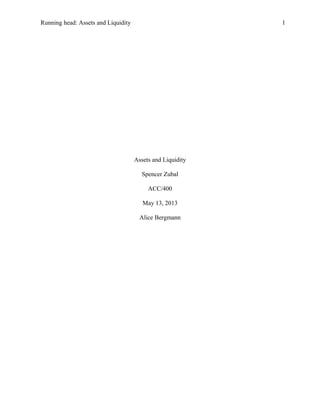Assets and liquidity
•Download as DOC, PDF•
0 likes•201 views
ACC/400 ACCOUNTING FOR DECISION MAKING Week 1 individual assignment
Report
Share
Report
Share

Recommended
Recommended
More Related Content
Similar to Assets and liquidity
Similar to Assets and liquidity (20)
A study of working capital management in ajanta pharma limited

A study of working capital management in ajanta pharma limited
Explain the term liquidity and how it relates to the classified bala.pdf

Explain the term liquidity and how it relates to the classified bala.pdf
Week 5ACC 290 Week 5 DQ1(What is the Control Environment).docx.docx

Week 5ACC 290 Week 5 DQ1(What is the Control Environment).docx.docx
Assets and liquidity
- 1. Running head: Assets and Liquidity 1 Assets and Liquidity Spencer Zubal ACC/400 May 13, 2013 Alice Bergmann
- 2. 2 Assets and Liquidity Every business organization must account for a variety of daily activities. Companies need to account for assets and liabilities, as well as track cash flow. The representation of these processes can be found on the balance sheet in a generalized way. It is a way for those who has stake in the company, such as investors and employees, along with the public to see where a company stands with its current and non-current assets. Both types of assets can be converted into cash or cash equivalents. The length of time it takes for the process of liquidation to occur is what sets them apart from each other. It is important for a company to keep track for the current and non-current assets and for a company to know how fast they can be liquidated. Assets are any item that can be converted to cash or cash equivalent. Current assets are used to pay expenses and fund day to day activities. Current assets are short-term gains and are identified in a variety of ways such as, cash, accounts receivables, pre-paid expenses, and market securities. Current assets are easily turned into cash and done so within the accounting year. Non-current assets on the other hand are long-term investments. Non-current assets are capitalized over a long period of time and the fulfillment is not realized with in the accounting year; but is allocated over the number of years of their usefulness. Types of non-current assets are property, plant, equipment, stocks, and bonds. The length of time an asset can be converted into cash is what separates current assets from non-current assets. Current assets has a quick liquidation time, while non-current assets have long-term liquidation, or even not turned into cash in the end of their usefulness. Liquidation is the ability to turn an asset in to cash. The more liquid an asset is means the quicker it can be turned into cash. The order of liquidity shows the assets listed on the balance sheet in the order of how fast they can be turned into cash. The first to be listed is cash, followed
- 3. 3 by market securities, next is accounts receivables, then inventory, fixed assets, and the last is goodwill. The order of liquidity is a simple way of listing assets in order of most liquid so the balance sheet could be easily read. Current and non-current assets represent the items that can be converted into cash or cash equivalents. Listing them in order of liquidity is an easy way for those invested in the company and even those outside the company to see how a company is allocating funds. Although the length of time is different when converting to cash both is really important for a company to have. Tracking the current and non-current assets will not only show how fast assets can be liquidated it shows where the cash brought in is being allocated. A company wants to have money spread out between long-term and short-tern assets.